Zippers are one of the most useful inventions when it comes to clothes fasteners. There are many types of zippers that all have specific uses beyond simply holding clothing and accessories together. Zippers are extremely versatile and can be used on many different items – but what are some zipper alternatives?
There are many alternatives to zippers when it comes to fasteners for clothes and other items – buttons being one of the most popular and versatile choices. Some other zipper alternatives include snaps, hook and eye closures, fabric ties, laces, velcro, buckles, and magnets.
In this article, we will go over different types of clothing fasteners when looking for an alternative for zippers. We will cover how they work and what they work best on. We will also go over the best alternatives to zippers specifically for jeans and bags.
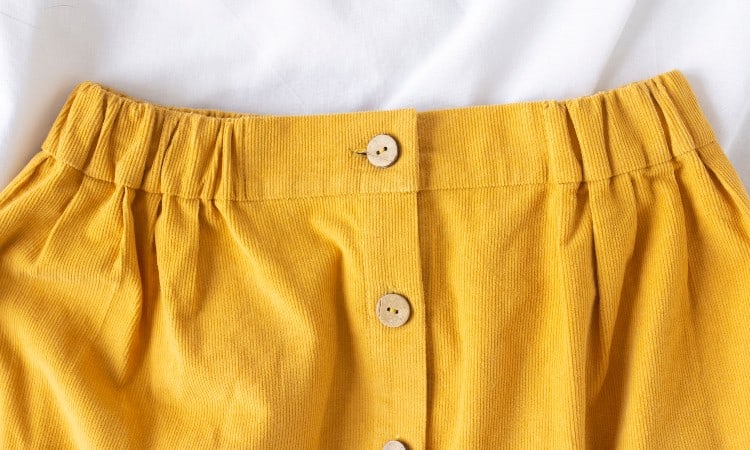
Zipper Alternatives
A zipper is somewhat of a miracle closure. There are several different kinds that all serve specific purposes. They can be made of metal or plastic and come in any rainbow color – further adding to their versatility.
If you don’t want to use a zipper, plenty of alternative closures are available to get the job of holding things together. Some – like buttons – are also super versatile and can be used for many applications. Others may be best used for more specific purposes.
Below we will cover the most common zipper alternatives – how they function and what they are best used for.
Buttons

Buttons are one of the original closures – easy to use and can be used in many ways. Buttons can be used purely for function. Or they can add a statement or a flare to something that needs jazzing up.
Buttons come in many different sizes and types. They can be made of many different materials – plastic, wood, glass, shell, fabric, metal, or horn, just to name a few. They come in any color imaginable. And though round is their most common form, buttons can also be found in just about any shape you’d imagine.
When we think of buttons, the first thing that comes to mind is the classic flat button with two or four holes. But if you dig a bit deeper – there are many different styles of buttons. Many buttons serve a specific purpose – because they work best with a certain type of material or item.
Buttons are also a great way to add a bit of personality to any item that needs closure! Repurposing buttons from old garments – especially vintage or antique items – is a great way to add a special effect. Or you could purchase a specific button that would add the perfect aesthetic to your piece.
Buttons themselves are pretty simple, but to use a button, one must have a buttonhole. Buttonholes can be a bit more work to put into place – it is a somewhat tedious process to sew them by hand. But there are accessories you can place buttonholes relatively easily with a home sewing machine.
A buttonhole is usually ¼ to ⅓ in larger than the button itself – depending on the type of button you’re using. A buttonhole foot can be attached to a sewing machine to make buttonholes quickly and with ease. Once sewn – the hole can be opened by hand using a straight pin and seam ripper. If you don’t want to sew the buttons by hand either, button sew-on feet can be purchased to do this quickly!
Beyond color and material – there is the button type itself. Below we will go over the six different types of buttons.
Flat Buttons
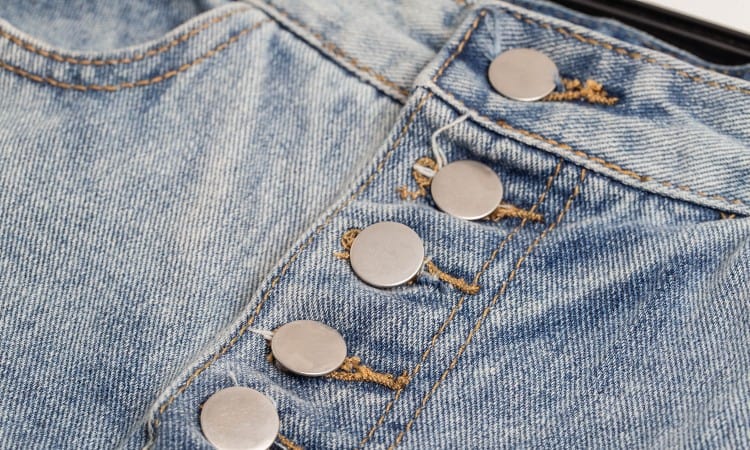
The most widely used type of buttons are flat buttons. These are the buttons you’ll find on a button-up shirt – they lie flat against the garment’s fabric. In most cases, flat buttons will have two or four holes at their center for the thread to be passed through to attach them.
The holes in two holed button will be lined up parallel to each other. Four hole buttons will have the holes lined up in two rows. Four hole buttons are sturdier than two-hole ones since they are held on with twice as much thread. Therefore these buttons will often be the choice for heavier fabrics or items that will get a lot of buttoning and unbuttoning traffic.
Flat buttons are easy to sew on by hand – though it can take a bit of time if you need to sew on many. They can also be sewn by machine if it has the capability and/or the right attachment.
Flat buttons can come in all manner of materials. Plastic buttons come in all sizes, colors and feel – even ones meant to appear like other materials like glass or wood. Glass, wood, metal, shell, and bone can also be used to make flat buttons.
Shanked Buttons
 Shanked buttons are those that have no holes in their appearance. Shanked buttons have a solid button surface that sits on a “stem” or shank, which houses the hole through which the thread will pass. Shanked buttons feature a single hole in which to be sewn.
Shanked buttons are those that have no holes in their appearance. Shanked buttons have a solid button surface that sits on a “stem” or shank, which houses the hole through which the thread will pass. Shanked buttons feature a single hole in which to be sewn.
Shanked buttons can come in many different looks – from basic and plain to detailed and ornate. Patterns are often molded onto this type of button – this works great since there are no holes to interfere with the button design.
Shanked buttons are often fabric covered which is ideal for buttons that discreetly blend in with the garment. Fabric-covered buttons can also be used the opposite way – to add a contrasting pop – especially if the fabric used is in a unique pattern. Fabric-covered buttons can be flat or rounded on top. Shank buttons can come in all sorts of other materials, such as plastic, wood, and metal.
Shanking a button can only be done by hand. Since they don’t lie flat and require a bit of manipulation to sew – shank buttons cannot be attached by the machine.
Toggles
 Toggles are different in shape than traditional buttons – but they are buttons nonetheless. They can vary somewhat in shape but are generally bar-shaped and somewhat larger. Traditionally – toggles are connected to the fabric by a cord that goes through two holes in the toggle. But they can sometimes be connected by a shank.
Toggles are different in shape than traditional buttons – but they are buttons nonetheless. They can vary somewhat in shape but are generally bar-shaped and somewhat larger. Traditionally – toggles are connected to the fabric by a cord that goes through two holes in the toggle. But they can sometimes be connected by a shank.
Instead of being fed through a buttonhole – as with other buttons – toggles are fastened by being fed through a cord loop.
Toggles are often made from horn, wood, or bone – but they can also be found in all sorts of man-made materials, including plastics that imitate natural materials.
In most cases – toggles tend to be larger and therefore are great choices for bulkier items such as overcoats and bags. They can also add a functional accent to other garments like chunky sweaters.
Fabric Loops
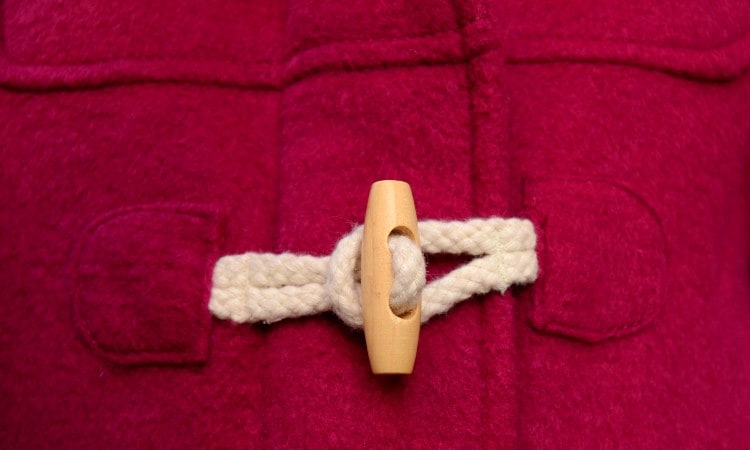
Fabric loops aren’t technically categorized as buttons – but they often function similarly, so they must be considered when discussing zipper alternatives.
Fabric loops can be used as fasteners in many ways, the first being a necessary component for toggles. The way in which toggles fasten clothes is by being fed through a fabric loop that holds them in place.
Fabric loops can be used to secure most traditional buttons as well – using the loop in place of a traditional buttonhole. In some cases – sewing on a loop may be a much easier route. However, this isn’t always an option depending on the garment itself.
These loop closures can be composed of just about any cord-like material. Cords, thread, rouleau, braided materials, ribbons – anything that can make a small loop to slip the button through. The thickness of the fabric loop should depend on the size and style of the button that it is meant to accommodate.
Frog Closures
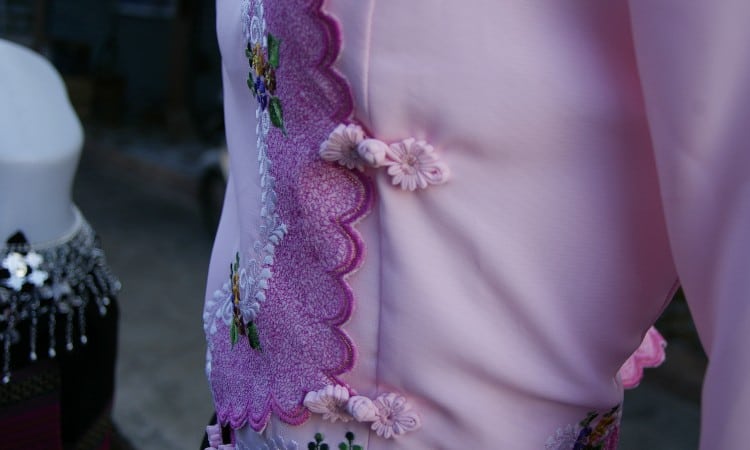
A frog closure is technically a type of fabric loop. Often used as a decorative element – frog closures are composed of ornamental braided knots made of the cord of varying thicknesses. The braided knots that makeup frogs are usually symmetrical on both sides. One side will house a loop and the other the button – often a braided ball – to slip through it.
Frog closures are a traditional Chinese craft that dates back many years. In China, they are referred to as pankou knots. In English – in addition to being called frog closures – they can be referred to as frogs or frogging.
These closures are often used in traditional Chinese garments and can be relatively simple or very ornate. In most cases, frogs are used as a fastener for clothing without creating an overlap in the fabric.
Stud Buttons AKA Jeans Buttons
 Stud buttons are most often seen on a pair of jeans – hence their alternative name. Stud buttons are made of metal and are studded onto the material. They require no sewing and are easy to install but do require a special tool to do so.
Stud buttons are most often seen on a pair of jeans – hence their alternative name. Stud buttons are made of metal and are studded onto the material. They require no sewing and are easy to install but do require a special tool to do so.
Stud buttons come in two pieces. The top is the button itself and then there is a pin that is pushed into the back of the button through the inside of the fabric. The fabric is sandwiched between the pin and the button, keeping it in place.
Stud buttons will require a buttonhole – or loop of some sort – to be a fully functioning closure. These fasteners are usually pretty heavy-duty, so they are best used with thicker, heavier fabrics like denim and other sturdy cotton. Thin, delicate fabrics – such as silk – would not be sturdy enough to hold a stud in place and would most likely rip and become damaged.
Studs buttons can be found on almost every pair of jeans out there. In cases where the jeans do have a zipper – they will also have at least one stud button at the top to help keep the zipper secure. Stud buttons are also often used as an alternative to zippers – with three or four studs lined up vertically at the fastening – aptly named a button fly.
Snap Fasteners
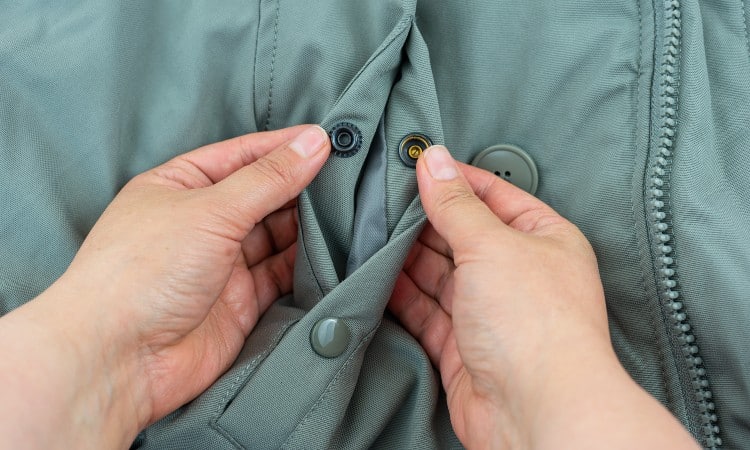
Snaps are a very handy alternative fastener to zippers. They are pretty simple to attach and make fastening and unfastening a breeze! This is one reason they are a great choice for anyone with dexterity problems. When put together – snaps form a very strong hold, but one that is relatively easy to detach.
As with any other type of button – there are several different types of snaps. Two-piece snaps come with two sides – a socket and a stud, which are snapped into the socket. Each side is attached to a ring that contains small holes for attachment. Two-piece snaps can be sewn by hand.
Multi-piece non-sew snaps are the other most common type. These snaps function similarly – with a socket and stud being snapped together. The difference is in how they are attached to the fabric. Non-sew snaps come with pronged rings. These prongs poke through the fabric and are bent and hammered into place. Non-sew snaps require a special tool – snap pliers – to be attached.
Another commonly found type of snap fastener is snap tape. This easy-to-install fastener is a strip of sturdy cotton fabric that already has snaps installed at equal increments. The snap tape can then be cut to the desired length and sewn onto the area that needs closure. Snap tape is often used for baby clothes.
Snaps can be made of various materials – most commonly, they are metal or plastic.
Hook and Eye Closures
 Hook and eye closures fastenings made from bent metal wire. They come in two pieces – on one side, the wire is fashioned into a hook. On the other – the eye is a sort of C-shaped loop. The hook clamps onto the eye for fastening.
Hook and eye closures fastenings made from bent metal wire. They come in two pieces – on one side, the wire is fashioned into a hook. On the other – the eye is a sort of C-shaped loop. The hook clamps onto the eye for fastening.
Most commonly – hook and eye closures are small and lightweight yet sturdy. They are a great option for small items or garments that require closure in a tight area. The place where the hook and eye fasteners are most abundant is in bras and lingerie.
Hook and eye closures are a great alternative to zippers, but they are also often used in conjunction with zippers – specifically invisible zippers that tend to be daintier. One or two hook and eye closures will be placed at the top of the zipper to help keep the zipper up.
Eyelets
 Eyelets are another zipper alternative requiring a special installation tool – called eyelet pliers. The process is similar to non-sew snaps and stud buttons. Two metal pieces are clamped together around the fabric that is held in place between.
Eyelets are another zipper alternative requiring a special installation tool – called eyelet pliers. The process is similar to non-sew snaps and stud buttons. Two metal pieces are clamped together around the fabric that is held in place between.
To properly install an eyelet – a small hole must first be made in the fabric where the eyelet will be placed. Depending on the type of fabric you’re working with, you may want to treat the raw edge with a seam sealant to help avoid unwanted ripping.
Eyelets are often used as a finishing to where drawstrings are used, and can also be found on many types of boots and shoes – through which laces will be threaded.
Eyelets are useful for shoes and can be used as zipper alternatives on any garment that can be laced up. Corsets often contain eyelets, like many wedding dresses and other types of gowns.
Eyelets are most often made of metal, but they can also be made of plastic.
Grommets
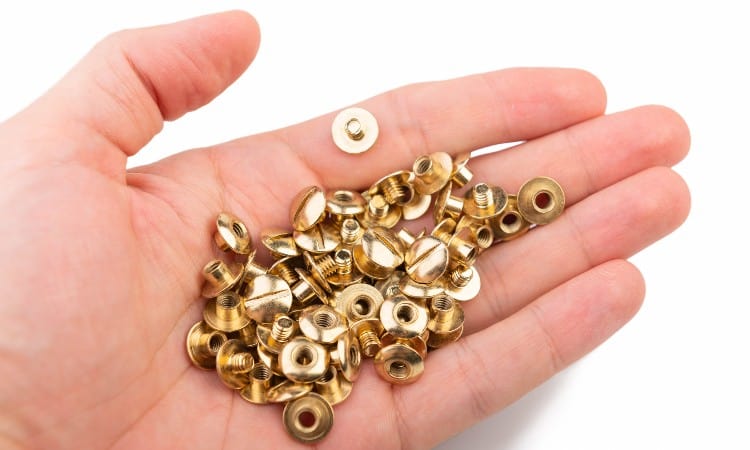
Grommets are often put in a category with eyelets. They are very similar in look and function in much the same way. The main difference between grommets and eyelets is their size.
Grommets are much larger and more heavy-duty than eyelets. This is why they are often found in places that need a sturdier hold.
Grommets can be used on heavy-duty garments like outerwear, and are often found in home decor items such as drapes and shower curtains.
Buckles
 Buckles come in all shapes and sizes – most commonly, they come to mind when we think of belts. But another widely used type of buckle is a fastener on jumpers or overalls. This type of buckle will have a “loop” portion that squeezes over a stud button to hold a strap in place.
Buckles come in all shapes and sizes – most commonly, they come to mind when we think of belts. But another widely used type of buckle is a fastener on jumpers or overalls. This type of buckle will have a “loop” portion that squeezes over a stud button to hold a strap in place.
In most cases, buckles will be made of metal. They work great for thick, heavy-duty items – such as the aforementioned overalls- with coats, pants, backpacks, and bags.
Velcro
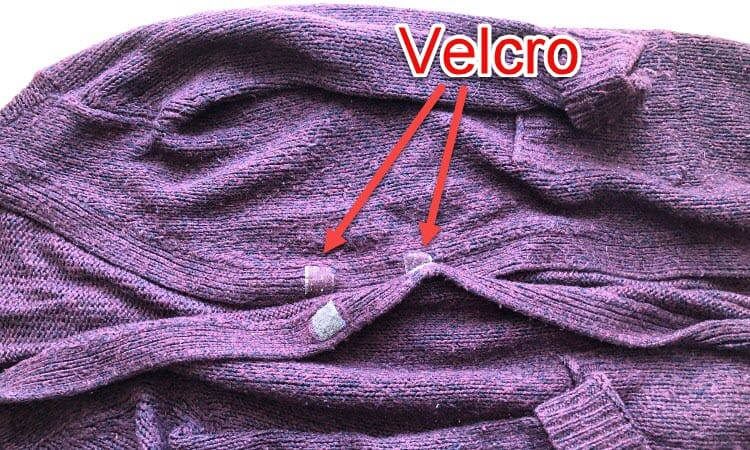
Velcro is another popular zipper alternative, similar to a zipper in that it has two sides that attach along the entire length of the opening. It also creates a great seal without gaps, similar to a zipper.
Velcro – also known as hook and loop tape – can be sewn into place or attached with adhesives. While it rates high for functionality – on most items that use velcro, the fastening isn’t visible. Therefore, this isn’t a great choice for aesthetics or somewhere you want to add a visual element.
Fabric Ties
Fabric ties are an easy way to add closure if you’re looking for a zipper alternative. Fabric ties are super versatile. Simply put, they are two pieces of fabric that can be tied together.
Fabric ties don’t have to be made from fabric, per se, but could be any sort of cord, braid or other material that can be tied together.
Fabric ties can be used as shirt straps to hold necklines together on aprons, halter tops, and many sorts of dresses.
Magnets
 Magnets may not be the most common choice for zipper alternatives – but they do make for a handy clothing fastener.
Magnets may not be the most common choice for zipper alternatives – but they do make for a handy clothing fastener.
Magnets can be used similarly to snaps. Opposing sides of a magnet will be attached to the opposite sides of the item that needs to be fastened. When the magnets come together, the item will be held closed.
When used with clothing – magnet snaps will often be enclosed fabric to make them less obtrusive and more comfortable to wear.
Magnet closures are a popular choice for purses and bags.
Zipper Alternatives for Jeans
Zippers are hands down the number one choice when it comes to fastening jeans. Most often, a pair of jeans will have a metal zipper fly. A stud button is placed above the zipper to better fit around the waist and help keep the zipper zipped.
Zippers are easy and convenient for jeans – but if you’re looking for an alternative, the best choice will be buttoned. As explained above – jeans even have a special button named for them.
Jeans with a button fly are a great choice to jeans with a standard zipper. Button flies will be secure and break less often than a zipper. They also tend to be very figure-flattering.
Zipper Alternatives for Bags
Zippers can be found on all sorts of bags! They are the most common closure found on backpacks – but zippers can also be found on purses ranging from budget-friendly to very high-end.
That being said – a zipper is not the only closure that can be used for bags. Drawstrings are a great zipper alternative for many styles of bags – including backpacks. Drawstrings allow a bag to open wide for easy access. They are also super sturdy. Drawstrings will rarely cause problems having to do with breakage. And if they do, it’s an easy fix to repair.
If functionality is your top priority – velcro can be a great choice for bags. Very easy to open and close. Magnets also provide an easy opening for many types of bags – though usually not the most secure type of fastening.
Buttons, of course, are also a great zipper alternative for many sorts of bags. There are probably as many button choices as types of bags to choose from. Just pick the type of button that works best with the bag you happen to be working on.
Conclusion
Zippers are versatile and convenient closures. They can be used in many ways on many different products. It would be easy to argue that a zipper is the number one choice for fasteners. But zippers aren’t the only closure that can keep your clothes together.
Whether talking about form or function – there are hundreds of options to choose from when it comes to zipper alternatives. Fasteners can be chosen because they will do the best job or because you want to add a statement or specific look to a piece. In either case – what would your first choice be for an alternative to a zipper closure?